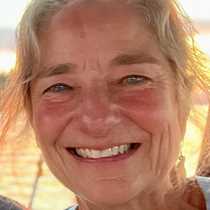At 6:30 a.m. our ship “crossed the bar,’” meaning we went over a terminal moraine where a glacier had deposited a ridge of rock material on the sea floor. The glacier has receded more than 30 miles, and it left behind a dramatic, narrow fjord called Tracy Arm. During the morning we explored a forested area that has been free of ice for hundreds of years, and in the afternoon we observed the glacier at close range from small boats.
We stepped ashore on a cobble beach in Williams Cove, and investigated coastal temperate rain forest. We walked past giant leaves of skunk cabbage, trudged through mud, and entered the rain forest. Every surface was host to something alive: lichens, mosses, ferns, and small plants grew on the bark and branches of towering trees. Many tree trunks were so straight they looked like telephone poles. The mossy forest floor was soft and spongy, and mosses covered high tree branches, too. The forest seemed to have every shade of green, and it was lush and damp. While we walked ashore, others kayaked, or looked around Williams Cove from small inflatable boats.
By lunchtime we were aboard the ship, and cruising up the 32-mile-long fjord that ends at South Sawyer Glacier. A forest takes hundreds of years to form after a glacier retreats, and traveling up the inlet was like traveling back in time. Rounded mountains surrounded us, with some U-shaped valleys where other glaciers once stood. Alders and willows grew on narrow ledges, but close to the existing glacier only mosses and lichens were living on the rocks. Right next to the ice, the rocks were totally bare.
We boarded small inflatable boats to view the face of South Sawyer Glacier. Harbor seals surfaced, and then slipped quietly beneath the green water. Ice chunks the size of cars and kitchen appliances drifted in currents, and some carried resting seals. South Sawyer Glacier calved large chunks of ice, it thundered loudly, and then it calved some more, sending up tall splashes and gentle swells. The glacier seemed especially blue today. Some of us touched smaller pieces of ice formed from snow that fell about 500 years ago.







